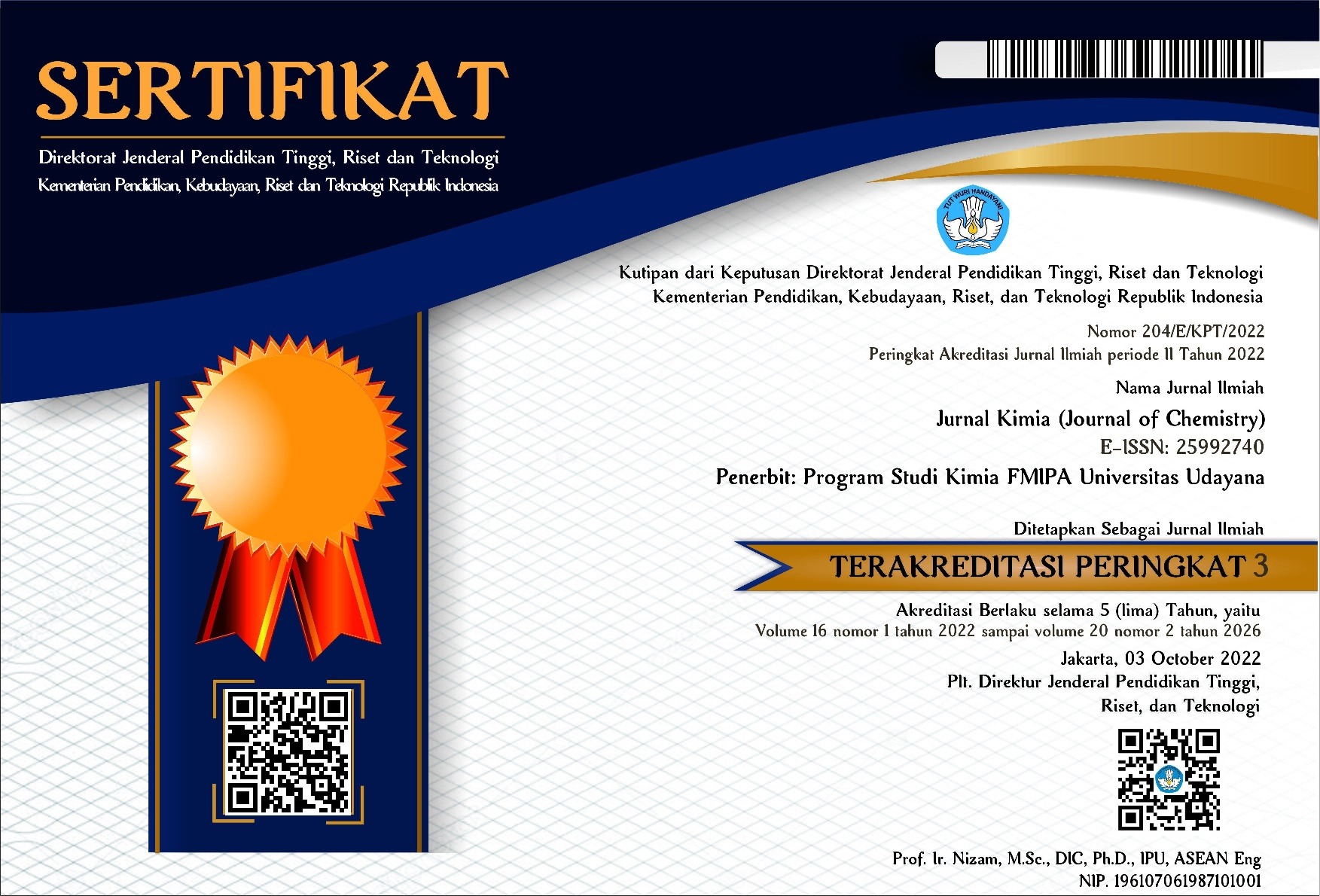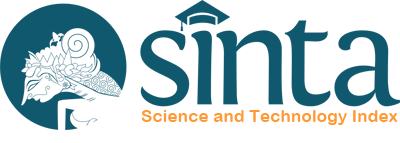PEMANFAATAN SELULOSA DARI KULIT SINGKONG SEBAGAI BAHAN DASAR PEMBUATAN SEDOTAN RAMAH LINGKUNGAN
Abstract
Penggunaan sedotan biodegradable merupakan salah satu cara untuk mengurangi kerusakan lingkungan yang disebabkan oleh sedotan plastik. Dalam penelitian ini, sedotan dibuat terutama dari selulosa, dengan penambahan kitosan sebagai agen hidrofobik dan pati sebagai perekat. Selulosa diisolasi dari kulit singkong melalui proses delignifikasi menggunakan larutan NaOH 1% pada suhu 80°C selama 2 jam, diikuti dengan proses pemutihan dengan NaClO2 10% dan asam asetat glasial dengan perbandingan 4:1 v/v pada suhu 80°C selama 2 jam. Terakhir, proses hidrolisis asam dilakukan dengan menggunakan H2SO4 5M pada suhu 80°C selama 2 jam. Selulosa yang diekstraksi digunakan untuk menyiapkan sedotan dengan dan tanpa penambahan lilin lebah. Karakterisasi sedotan meliputi kekuatan tekan, uji pembengkakan, dan analisis termal menggunakan DSC. Hasil penelitian menunjukkan bahwa selulosa yang diperoleh dari proses delignifikasi, pemutihan, dan hidrolisis asam masing-masing sebesar 51,11 ± 0,56%, 76,29 ± 4,41%, dan 19,85 ± 5,83%. Kandungan alfa-selulosa setelah hidrolisis sebesar 91,25%, dan spektrum FTIR menunjukkan adanya puncak peregangan O-H pada bilangan gelombang 3336,0 cm-1 dan puncak peregangan C-H pada 2905,5 cm-1 yang menunjukkan adanya senyawa hidrokarbon alkana alifatik. Hasil uji swelling sedotan tanpa dan dengan lilin lebah masing-masing sebesar 58,56 ± 0,02% dan 12,58 ± 13,28% selama 30 menit. Nilai kuat tekan sedotan adalah 235,06 ± 48,57 N, dan karakteristik termal menunjukkan transisi kaca sebesar 266°C dan titik leleh sebesar 237°C. Uji karakteristik fisik didapatkan sedotan yang dihasilkan berbentuk padat, tidak berbau, tidak berasa, berwarna cokelat muda, dan bertekstur kasar. Hasil penelitian menunjukkan bahwa sedotan ramah lingkungan yang dihasilkan memiliki sifat fisik yang baik. Produk ini berpotensi menjadi alternatif yang ramah lingkungan pengganti sedotan plastik dan mendukung upaya pengurangan limbah plastik.
Kata kunci: biodegradable; kitosan; kulit singkong; sedotan; selulosa
ABSTRACT
Using biodegradable straws is a way to reduce the environmental damage caused by plastic straws. In this study, the straws were made primarily from cellulose, with the addition of chitosan as a hydrophobic agent and starch as an adhesive. Cellulose was isolated from cassava peel through a delignification process using 1% NaOH solution at 80°C for 2 hours, followed by a bleaching process with 10% NaClO2 and glacial acetic acid in a ratio of 4:1 v/v at 80°C for 2 hours. Finally, an acid hydrolysis process was carried out using 5M H2SO4 at 80°C for 2 hours. The extracted cellulose was used to prepare the straws with and without the addition of beeswax. The characterization of the straws included compression strength, swelling tests, and thermal analysis using DSC. The results showed that the cellulose obtained from the delignification, bleaching, and acid hydrolysis processes were 51.11 ± 0.56%, 76.29±4.41%, and 19.85±5.83%, respectively. The content of alpha-cellulose after hydrolysis was 91.25%, and the FTIR spectra showed an O-H stretching peak at wave number 3336.0 cm-1 and a C-H stretching peak at 2905.5 cm-1 that indicated the presence of aliphatic alkane hydrocarbon compounds. Swelling test results of the straws without and with beeswax were 58.56 ± 0.02% and 12.58 ± 13.28%, respectively, over 30 minutes. The compression strength value of the straws was 235.06 ± 48.57 N, and the thermal characteristics showed a glass transition of 266°C and a melting point of 237°C. The resulting biodegradable straws were solid, odorless, tasteless, light brown, and had a rough texture. Physical characteristic tests resulted in biodegradable straws that are solid, odorless, tasteless, light brown, and rough textured. The results indicated that the straws had good physical properties. This product has the potential to be an environmentally friendly alternative to plastic straws and supports efforts to reduce plastic waste.
Keywords: biodegradable; chitosan; cassava peel; cellulose; straw
Downloads
References
Aditama, A. G., & Ardhyananta, H. 2017. Isolasi selulosa dari serat tandan kosong kelapa sawit untuk nano filler komposit absorpsi suara: Analisis FTIR. Jurnal Teknik ITS,. 6(2): F229-F232.
Arwini, N. P. D. 2022. Sampah plastik dan upaya pengurangan timbulan sampah plastik. Jurnal Ilmiah Vastuwidya. 5(1): 72-82.
Agustin, A. T. 2013. Gelatin ikan: sumber, komposisi kimia dan potensi pemanfaatannya. Media Teknologi Hasil Perikanan. 1(2).
Akhadiarto, S. (2010). Pengaruh pemanfaatan limbah kulit singkong dalam pembuatan pelet ransum unggas. Jurnal Teknologi Lingkungan. 11(1): 127-138.
Bayer, I. S., Guzman-Puyol, S., Heredia-Guerrero, J. A., Ceseracciu, L., Pignatelli, F., Ruffilli, R., ... & Athanassiou, A. 2014. Direct transformation of edible vegetable waste into bioplastics. Macromolecules. 47(15): 5135-5143.
Dewi, I. A., Ihwah, A., Setyawan, H. Y., Kurniasari, A. A. N., & Ulfah, A. 2019. Optimasi proses delignifikasi pelepah pisang untuk bahan baku pembuatan kertas seni. Sebatik. 23(2): 447-454.
Departemen Pertanian. Vademecum Kehutanan Indonesia. 1976.
Departemen Kesehatan Republik Indonesia. 2014. Farmakope Indonesia, Edisi V. Jakarta: Departemen Kesehatan Republik Indonesia. 798.
Dallan, P. R. M., da Luz Moreira, P., Petinari, L., Malmonge, S. M., Beppu, M. M., Genari, S. C., & Moraes, A. M. 2007. Effects of chitosan solution concentration and incorporation of chitin and glycerol on dense chitosan membrane properties. Journal of Biomedical Materials Research Part B: Applied Biomaterials: An Official Journal of The Society for Biomaterials, The Japanese Society for Biomaterials, and The Australian Society for Biomaterials and the Korean Society for Biomaterials. 80(2): 394-405.
Ehrman, T. 1996. Determination of acid-soluble lignin in biomass. NREL Chemical Analysis and Testing Task Laboratory Analytical Procedure. 004: 1-7.
Fadhilah, M. R. 2022. Karakterisasi Kitosan dari Fungi 19A15-RF (Aspergillus ochraceus) yang Berasosiasi Dengan Spons.
Hidayat, F., Syaubari, S., & Salima, R. 2020. Pemanfaatan Pati Tapioka dan Kitosan dalam Pembuatan Plastik Biodegradable dengan Penambahan Gliserol sebagai Plasticizer. Jurnal Litbang Industri. 10(1):33-38.
Irmayani, I., & Syahril, S. 2020. Kebijakan Cukai Kantong Plastik Sebagai Dampak Eksternalitas Lingkungan. EKOMBIS: JURNAL FAKULTAS EKONOMI. 6(1).
Jambeck, J. R., Geyer, R., Wilcox, C., Siegler, T. R., Perryman, M., Andrady, A., & Law, K. L. 2015. Plastic waste inputs from land into the ocean. Science. 347(6223): 768-771.
Jacobsen, P. L. 2011. The Little Lip Book. Carma Laboratories. Inc, USA.
Kusumawati, E., & Haryadi, H. 2021. Ekstraksi dan Karakterisasi Serat Selulosa dari Tanaman Eceng Gondok (Eichornia Crassipes). Fluida. 14(1): 1-7.
Khantayanuwong, S., Khemarom, C., & Salaemae, S. 2017. Effects of shrimp chitosan on the physical properties of handsheets. Agriculture and Natural Resources. 51(1): 53-56.
Kanani, N., Ekasari, E., Subkhan, A., Wardalia, W., & Riky, R. 2018. Pengaruh penambahan gliserol dan lilin lebah pada susut berat buah sawo khas Banten. Jurnal Konversi. 7(2): 8.
LE, W. 1946. Chlorite holocellulose, its fractionation and bearing on summative wood analysis and on studies on the hemicelluloses. Tech Assoc Pap. 29: 210-218.
Liu, J., Wang, C., Ewulonu, C. M., Chen, X., Wu, M., & Huang, Y. 2022. Fabrication of superhydrophobic and degradable cellulose paper materials for straw application. Cellulose. 29: 527-540.
Lestari, D. 2013. Pengaruh Substitusi Tepung Tapioka Terhadap Tekstur dan Nilai Organoleptik Dodol Susu (Doctoral dissertation, Universitas Brawijaya).
Laksono, A. D., & Agustiningtyas, D. T. 2019. Pengaruh Faktor Geografi Terhadap Karakteristik Bambu Petung. SPECTA Journal of Technology. 3(1): 25-32.
Lestari, R. S. D., Jayanudin, J., Irwanto, D., Bahaudin, R., Wardhana, R. L., & Muhammad, F. 2020. Preparasi dan karakterisasi kitosan tertaut silang glutaraldehida sebagai matrik Pupuk urea. Jurnal Integrasi Proses. 9(2): 27-33.
Muhammad, M., Ridara, R., & Masrullita, M. 2021. Sintesis Bioplastik dari Pati Biji Alpukat dengan Bahan Pengisi Kitosan. Jurnal Teknologi Kimia Unimal. 9(2): 1-11.
Mulyadi, I. 2019. Isolasi dan karakterisasi selulosa. Jurnal Saintika Unpam: Jurnal Sains dan Matematika Unpam. 1(2): 177-182.
Muhammad, M., Ridara, R., & Masrullita, M. 2021. Sintesis Bioplastik dari Pati Biji Alpukat Dengan Bahan Pengisi Kitosan. Jurnal Teknologi Kimia Unimal. 9(2): 1-11.
Mackay, R. G., & Tait, J. M. 2012. Handbook of chitosan research and applications. (No Title).
Mosquera, M. R. 2019. Banning plastic straws: the beginning of the war against plastics. Earth Jurisprudence & Envtl. Just. J. 9: 5.
MAILLARD, M. R. 2019. Pembuatan Kitosan Termodifikasi. Jurnal Kimia dan Kemasan. 41(2): 105-109.
Nuringtyas, T. R. 2010. Karbohidrat. Universitas Gajah Mada, Yogyakarta.
Nuwa, N., & Prihanika, P. 2018. Tepung Tapioka Sebagai Perekat dalam Pembuatan Arang Briket: Tapioca Flour as in Adhesive Making of Bricket. PengabdianMu: Jurnal Ilmiah Pengabdian kepada Masyarakat. 3(1): 34-38.
Putera, R. D. H. 2012. Ekstraksi serat selulosa dari tanaman eceng gondok (Eichornia crassipes) dengan variasi pelarut. Skripsi, Universitas Indonesia, Depok.
Qiu, N., Sha, M., & Xu, X. 2022. Evaluation and future development direction of paper straw and plastic straw. In IOP Conference Series: Earth and Environmental Science. 1011(1): 012029. IOP Publishing.
Qadri, O. R. J., Hamzah, F. H., & Ayu, D. F. 2023. Variasi konsentrasi kitosan dalam pembuatan bioplastik berbahan baku jerami nangka. Agrointek: Jurnal Teknologi Industri Pertanian. 17(1): 106-113.
Rowell, R. M. 2005. Handbook of wood chemistry and wood composites. CRC press.
Rowe, R. C., Sheskey, P., & Quinn, M. 2009. Handbook of pharmaceutical excipients. Libros Digitales-Pharmaceutical Press.
Sari, A. M., Hendrawati, T. Y., Ananda, K. R., & Erdawati, E. 2020. Pengaruh Variasi Massa Kitosan Terhadap Yield dalam Pembuatan Nanoemulsi Kitosan dengan Metode Gelasi Ionik dan Freezing. Jurnal Teknologi. 12(2): 107-122.
Syafii, W., & Siregar, I. Z. 2006. Sifat Kimia dan Dimensi Serat Kayu Mangium (Acacia mangium Willd.) dari Tiga Provenans. Chemical Properties and Fiber Dimension of Acacia mangium Willd. from Three Provenances. Jurnal Ilmu dan Teknologi Kayu Tropis. 4(1): 28-32.
Schrieber, R., & Gareis, H. 2007. Gelatine handbook: theory and industrial practice. John Wiley & Sons.
Safwani, S., & Riza, M. 2018. Synthesis of biodegradable plastic from tapioca with N-Isopropylacrylamid and chitosan using glycerol as plasticizer. In IOP Conference Series: Materials Science and Engineering. 345(1): 012049. IOP Publishing.
Saputro, D. F., Widiarto, S., & Yuwono, S. D. 2016. Studi Pendahuluan Pembuatan dan Karakterisasi Plastik Ramah Lingkungan dari Campuran Polisterena-Poli Asam Laktat. In Prosiding Seminar Nasional Sains, Matematika, Informatika dan Aplikasinya. 3(3).
Sasria, N., Asrilsyah, A., Lubis, M. P. D., Zulfikar, A., & Tanjung, R. A. 2020. Sintesis dan karakterisasi plastik biodegradable berbasis pati nasi aking dan kitosan cangkang udang. Teknika: Jurnal Sains dan Teknologi. 16(2): 231-236.
Soebijanto, T. 1986. HFS dan industri ubi kayu lainnya. PT. Gramedia, Jakarta.
Safitri, M. D., & Fauzia, A. 2020. Sosialisasi Pengurangan Penggunaan Sedotan Plastik Di Lingkungan Sekolah dan Masyarakat. Jurnal Pengabdian Masyarakat MIPA dan Pendidikan MIPA. 4(2): 122-130.
Templeton, D., & Ehrman, T. 1995. Chemical analysis and testing task: LAP-003 (Determination of acid-insoluble lignin in Biomass) National Renewable Energy Laboratory. Golden, USA.
Tappi, T. 1997. 264 cm-97: Preparation of Wood for Chemical Analysis. Technical Association of the Pulp and Paper Industry.
Tappi, T. 2002. 211 om-02. Ash in wood, pulp, paper and paperboard: Combustion at 525◦ C. TAPPI test methods, 5.
Tappi, T. 1997. Solvent extractives of wood and pulp. TAPPI T. 204.
Wahidah, W. 2022. Konsep green economy pada produk sedotan purun di Desa Banyu Hirang, Kecamatan Amuntai Selatan, Kabupaten Hulu Sungai Utara. Doctoral dissertation. IAIN Palangka Raya).
Zhou, X., Yi, C., & Deng, D. 2021. Sustainable development strategy of beverage straws for environmental load reduction. In IOP Conference Series: Earth and Environmental Science. 784 (1): 012041. IOP Publishing.

This work is licensed under a Creative Commons Attribution 4.0 International License






